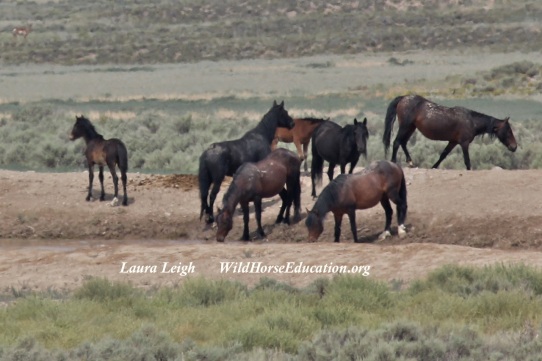
Leigh speaking to college students
WHE has been involved in wild horse and burro management issues in a “from the ground up” engagement concept. Gaining protections involve taking documentation to appropriate venues. You can not engage for change without it. Documentation has always been a key component in this fight from the 1959 law that began to address motor vehicle (planes and trucks) used in “mustanging,” to the passage of the 1971 law that gave jurisdiction to the federal government. (video and links at the bottom of this posting may be helpful).
WHE understand that when you “step up” for wild horses and burros you step into an arena filled with agency jargon and layers of political history. Do not give up in frustration. Your ability to understand what you read, and engage appropriately, is vital if we are going to see the kind of changes required.
Not only do you need to understand the factors involved in managing wild horses and burros, understanding the organizations that advocate for change will be very helpful as issues escalate. We are on the verge of an extraordinary time in history in the political realm, understanding where “we all fit” may help you understand how to craft your own voice.

Wild horses at water source in NV
WHE deals primarily with issues surrounding the Bureau of Land Management (BLM). BLM manages more wild horses than any other jurisdiction (More on different jurisdictions can be found here: http://wildhorseeducation.org/reality-of-wild-horse-slaughter/)
Our work has won legal efforts (the only ones in history) against inhumane treatment, to gain meaningful access and to stop unjustified removals. We were told it was impossible. It wasn’t. In addition we have worked in the field on multiple water issues, distribution and stopped some issues from becoming problems. Our work continues.

Exhausted foal carried limp back to the trap by wrangler. Owyhee Complex litigation.
Our work to gain daily access to government handling at roundups and to closed holding facilities: http://wildhorseeducation.org/2015/05/11/whe-works-access-and-the-right-to-know/
Our work to gain the first courts orders in history against inappropriate conduct at roundups (the only court orders in history) http://wildhorseeducation.org/2015/05/06/whe-works-humane-care/
WHE is also an organization that provides other organizations with on the ground documentation to move their efforts forward. Our work has not just moved our outreach, meetings and litigation forward, WHE has helped other organizations. As an example Pershing county recently dropped litigation against the BLM (AWHPC intervened). The underlying declaration that assisted that organization with “standing,” or the right to file, and provided on the ground information came from Laura Leigh, WHE President. The on the ground documentation that created the avenue for addressing BLM involvement with the McDermitt removal (that would place BLM horses in jeopardy of slaughter) also came from WHE. WHE has provided the “on the ground perspective” in multiple instances. (Often organizations will not mention our involvement. That hurts our efforts to continue to fund our work. We do not know why they do not tell you that we provide that basis for conversation, but that does not change the fact that we provide that service. WHE has never denied information that can help a horse, regardless of the political climate on any side of the fence).

“Remove and stockpile” is not management. BLM is mandated to manage wild horses, they are not mandated to remove. There are many tools never utilized. Can we stop the insanity?
WHE realize that issues can get very complicated. This is an article on some of the major discussions and “work zone” areas of today: http://wildhorseeducation.org/2015/09/20/whe-cut-to-the-chase-major-discussion-points-in-advocacy-today/
The video below was prepared as a fundraiser a few years ago. After supporters received their copies they all wrote and asked us to release it publicly. As it was originally published as a fundraiser you can skip the intro by going to timecode 1:22. The video is a rough cut created on a laptop. We have not had the funding to complete the three part series of videos. As an example we carried (or were involved in) 9 federal court actions in one year alone, travelled more than 100,000 road miles to document roundups and have otherwise been engaged in as an effective a manner as possible to create change.
We still need your help to stay in the fight. Interests that work against wild horses and burros are well funded, often backed by large corporate interests and county seats. WHE is a small organization that exists in a very competitive arena where we are “out gunned” by those that reap a constant profit from public land. If you can help us go to: http://WildHorseEducation.org/donate
Glossary of Acronyms: https://wildhorseeducation101.files.wordpress.com/2011/04/wheglossary2.pdf
Desktop guide to the “web of agencies and jurisdictions” https://wildhorseeducation101.files.wordpress.com/2011/04/wheagencyissue1.pdf
To understand the “NEPA” process: http://wildhorseeducation.org/nepa/
Major discussion points in advocacy today: http://wildhorseeducation.org/2015/09/20/whe-cut-to-the-chase-major-discussion-points-in-advocacy-today/
This video is a good place “to start” understanding some of the issues. Some of you will recognize “Elvis,” Leigh’s dog. The dog passed away as Leigh entered into treatment for breast cancer. Elvis had attended more days of wild horse roundups, in the three years he travelled the range, than any member of the public, press or government personnel. He was a constant companion.
Hold Your Wild Horses! how did it get so bad? from Laura Leigh on Vimeo.

Speaking to primary school students in Reno
WHE needs your help to stay in this fight.
You must be logged in to post a comment.